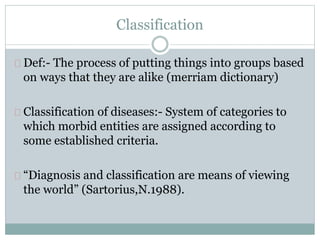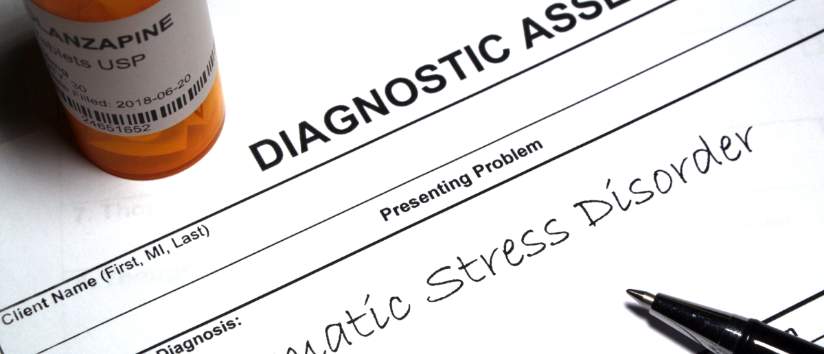Describe the System Used to Classify Psychological Disorders
The first edition of the DSM was published in 1952 and has undergone numerous revisions. In 1980 the American Psychiatric Association published the third edition of the Diagnostic and Statistical Manual of Mental Disorders DSM-III marking the first attempt to approach the diagnosis of mental illness through standardized definitions and criteriaThe latest edition DSM-5-TR published in 2022 provides a classification system that attempts to separate mental.

Diagnosing And Classifying Psychological Disorders Introduction To Psychology
Types of Communication Disorders.

. Supporters of the medical model consequently consider symptoms to be outward signs. 1 Hallucinations 2 Morositates 3 Deliria and 4 Folies Anomales. ICD-10 provides clinicians throughout the globe with a free and accessible classification system that can be used with relative ease by non-mental health clinicians most of whom work in general medical settings in.
Professionals is the DSM-5. Describe the basic features of the Diagnostic and Statistical Manual of Mental Disorders Fifth Edition DSM-5 and how it is used to classify disorders. There are currently two widely established systems for classifying mental disordersChapter V of the International Classification of Diseases ICD.
Both these approaches use a classification system based on categories. 3 Approaches to Classification of Mental Health Disorders. The Diagnostic and Statistical Manual of Mental Disorders DSM is a tool used by mental health professionals to diagnose various mental illnesses.
How do mental health professionals ascertain whether or not a. The most recent edition published in 2013 is the DSM-5 APA 2013. The first edition of the DSM was published in 1952 and has undergone numerous revisions.
There are currently two widely established systems for classifying mental disorders. Professionals is the DSM-5. In 1980 the American Psychiatric Association published the third edition of the Diagnostic and Statistical Manual of Mental Disorders DSM-III marking the first attempt to approach the diagnosis of mental illness through standardized definitions and criteriaThe latest edition DSM-5-TR published in 2022 provides a classification system that attempts to separate mental.
Army during World War II Clegg 2012. The medical model of mental illness treats mental disorders in the same way as a broken arm ie. The diagnosis and classification of psychological disorders is essential in studying and treating psychopathology.
Let me put out an example for better. The ICD-10 classification of mental and behavioral disorders preserves categories parallel to those used in DSM-IV although the descriptions are often different. It has been revised several times and the newest version is commonly referred to as the DSM-IV.
The classification system used by most US. Though controversial for many reasons this tool has been helpful since its first publishing in 1952 by the American Psychiatric Association APA. The DSM-IV uses a.
The diagnosis and classification of psychological disorders is essential in studying and treating psychopathology. In the years since the DSM has undergone numerous revisions and editions. The current authoritative scheme for classifying psychological disorders in the American psychiatric Associations DSM-IV Diagnostic and Statistical Manual of Mental Disorders fourth edition.
A first step in the study of psychological disorders is carefully and systematically discerning significant signs and symptoms. There is thought to be a physical cause. Language disorder speech sound disorder childhood-onset fluency disorder stuttering and social pragmatic communication disorder.
Describe system used to classify psychological disorders and explain the reason for its development. Chapter V of the tenth International Classification. The American Psychiatric Association published the first version of the DSM in 1952.
This model has been adopted by psychiatrists rather than psychologists. The APA has revised the manual five times since. The DSM published by the American Psychiatric Association mirrors the ICD in many ways.
However the ICD-10 classification does not use the checklist approach but rather gives a general description and the major criteria required. The classification of mental disorders is also known as psychiatric nosology or psychiatric taxonomyIt represents a key aspect of psychiatry and other mental health professions and is an important issue for people who may be diagnosed. Like the ICD the DSM uses a category-based system.
Within these categories were some familiar symptoms including induced vomiting mania amnesia hypersexuality panic and insomnia. Examples of DSM-5 classifications include neurodevelopmental disorders bipolar and related disorders sexual dysfunctions dissociative disorders and personality disorders among others. Anxiety is a diffuse extremely unpleasant feeling of vulnerability apprehension and fear.
The DSM and ICD both are detailed guides to diagnose mental health disorders. The following five of the thirteen in the DSMIV types of. In easier words certain conditions are categorized within a spectrum of a specific disorder.
The DSM-5 identifies four different subtypes of communication disorders. The 5th and most recent edition the DSM-5 was published in. These disorders are those that impact the ability to use understand or detect language and speech.
The first edition of the DSM published in 1952 classified psychological disorders according to a format developed by the US. Other symptoms like the uncontrollable impulse to dance and. The 5th and most recent edition the DSM-5 was published in.
Symptoms In the DSM classification system the ___________ distinguishes a disorder from similar disorders and the diagnostic criteria is a list of ___________ of a. The DSM describes disorders and their prevalence. The classification of mental disorders also known as psychiatric nosology or taxonomy is a key aspect of psychiatry and other mental health professions and an important issue for consumers and providers of mental health services.
Saul McLeod updated 2018. Psychologists and psychiatrists use a reference book called the Diagnostic and Statistical Manual of Mental DisordersDSM to diagnose psychological disorders. Now in its fifth edition this manual is a widely used diagnostic tool that provides criteria for the diagnosis of mental-health disorders and guidance for clinicians.
The International Classification of Mental Disorders is the most widely used system of medical classification throughout the world. This classification included mental illnesses subdivided into four categories. The classification system used by most US.
Symptoms of anxiety disorders include motor tension trembling jumpiness inability to relax hyperactivity racing heart dizziness perspiration and apprehension disturbing thoughts. In the DSM classification system _____ features are the main features that define a disorder and _____ features are additional features that are present.

Introduction To The Classification Of Mental Disorders Mht

Issues In Psychological Classifications Reliability Validity Labeling Video Lesson Transcript Study Com

A N G E L C O L O R S Study Notes Study Inspiration Study Motivation
No comments for "Describe the System Used to Classify Psychological Disorders"
Post a Comment